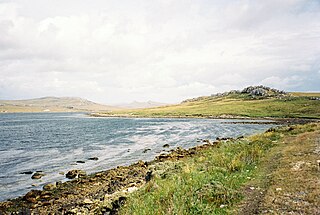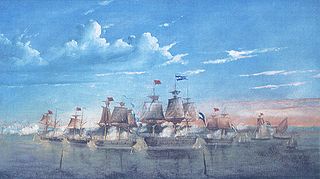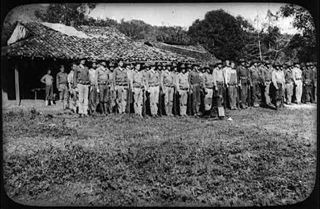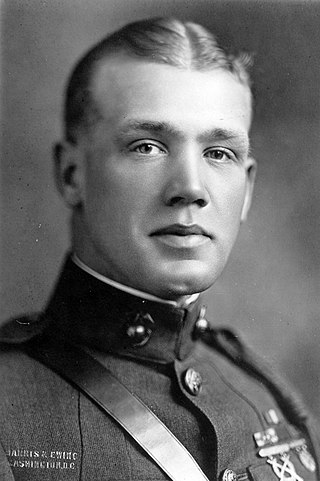
Lewis Burwell "Chesty" Puller was a United States Marine Corps officer. Beginning his career fighting guerillas in Haiti and Nicaragua as part of the Banana Wars, he later served with distinction in World War II and the Korean War as a senior officer. By the time of his retirement in 1955, he had reached the rank of lieutenant general.

The Battle of Mount Tumbledown was an engagement during the Falklands War. The engagement was an attack by the British Army and the Royal Marines on the heights overlooking Stanley, the Falkland Islands capital. Mount Tumbledown, Mount William and Sapper Hill lie west of the capital. Due to their proximity to the capital, they were of strategic importance during the 1982 War. They were held by the Argentine 5th Naval Infantry Battalion, a reinforced, cold weather trained and equipped Marine battalion.

Augusto César Sandino, full name Augusto Nicolás Calderón Sandino, was a Nicaraguan revolutionary and leader of a rebellion between 1927 and 1933 against the United States occupation of Nicaragua. Despite being referred to as a "bandit" by the United States government, his exploits made him a hero throughout much of Latin America, where he became a symbol of resistance to American imperialism. Sandino drew units of the United States Marine Corps into an undeclared guerrilla war. The United States troops withdrew from the country in 1933 after overseeing the election and inauguration of President Juan Bautista Sacasa, who had returned from exile.

Victor France Bleasdale was a brigadier general in the United States Marine Corps. He was awarded the Navy Cross and Distinguished Service Cross for his actions during the Battle of Blanc Mont Ridge in World War I. Later he received a second Navy Cross for his service at the Battle of San Fernando during the Second Nicaraguan Campaign.

The SecondBattle of Vailele was fought during the Second Samoan Civil War in 1899. British, American and Samoan forces loyal to Prince Tanu were defeated by a superior force of Samoan rebels loyal to Mata'afa Iosefo. Fighting occurred at the former German plantation of Vailele, Samoa and was a major engagement in the small colonial conflict.

The Battle of Martín García was fought from 10 to 15 March 1814 between the forces of the United Provinces of the Río de la Plata under the command of then-Lieutenant Colonel Guillermo Brown, and the royalist forces commanded by frigate captain Jacinto de Romarate, defending the region.

The Battle of Agua Carta, or the Battle of Lindo Lugar, was an engagement between the National Guard of Nicaragua and the rebels of Augusto César Sandino in 1932. It was fought near Mount Kilambe at the Agua Carta, a river in Sandino territory, as part of the American occupation of Nicaragua and a long lasting civil war.

The Battle of Ganjgal took place during the War in Afghanistan between American and Afghan forces and the Taliban in Kunar Province, Afghanistan on September 8, 2009. Complaints that the coalition casualties were avoidable and caused by a failure of the chain of command to provide fire support for the team triggered an official investigation and a series of reprimands to several US military officers. Army Captain William D. Swenson and Marine Corporal Dakota Meyer received the Medal of Honor for their actions during the battle. Meyer is the first living Marine to receive the Medal of Honor since the Vietnam War, and Swenson is the fifth living soldier and second officer to receive the Medal of Honor since the Vietnam War. Two other Marines at the battle, Staff Sgt. Juan Rodriguez-Chavez and Capt. Ademola Fabayo, received the Navy Cross.

The Battle of Ocotal occurred in July 1927, during the American occupation of Nicaragua. A large force of rebels loyal to Augusto César Sandino attacked the garrison of Ocotal, which was held by a small group of US Marines and Nicaraguan National Guards. Ultimately the rebels were defeated with heavy losses, while the Americans and their Nicaraguan allies suffered very light casualties.

The Battle of Telpaneca was an engagement fought during the United States occupation of Nicaragua in 1927.

The Second Battle of Las Cruces, or the New Year's Day Battle, was a major engagement during the American occupation of Nicaragua. It was fought on 1 January 1928, during an expedition to destroy a Sandinista fortress. A column of United States Marines and Nicaraguan National Guardsmen were attacked by a superior force of rebels entrenched on Las Cruises Hill and, after a long battle, the Americans and Nicaraguans routed the Sandinistas and captured their positions.

The Battle of La Ebonal was fought in December 1859 near Brownsville, Texas during the First Cortina War. Following the Brownsville Raid, on September 28, and a few skirmishes with the Texas Rangers, rebel leader Juan Cortina led his small army into the hills outside of town and dug in near a series of cattle ranches. The United States Army responded by sending an expedition into the area, under the command of Major Samuel P. Heintzelman, with orders to pacify all resistance. A minor battle began on December 13, at a ranch called La Ebonal, and continued for a few hours as the Americans routed and then pursued the retreating Cortinistas.

William Kirk MacNulty was a U. S. Marine. He was a U.S. Marine Corps second lieutenant during World War I and saw action at the Battle of the Argonne Forest. He served as a captain during the Second U.S. Nicaraguan Campaign (1926–1933). During the Second World War, as a lieutenant colonel he commanded the U.S. Marine Corps defense of Guam against Imperial Japanese forces during the First Battle of Guam. He was incarcerated by the Japanese as a prisoner of war. He was promoted to brigadier general during captivity and retired from military service in 1946. He is buried at the Golden Gate National Cemetery in San Bruno, San Mateo County, California.
The Battle of El Sauce, or the Battle of Punta de Rieles or Punta Rieles, took place on the 26 December 1932 during the American occupation of Nicaragua of 1926–1933. It was the last major battle of the Sandino Rebellion of 1927–1933. The incident has its origins in Nicaraguan President José María Moncada's plan to commemorate the completion of the León–El Sauce railway on 28 December 1932.
The Battle of San Fernando took place on July 25, 1927, during the American occupation of Nicaragua of 1926–1933. Shortly after the Battle of Ocotal, an expedition of seventy-eight American Marines and thirty-seven Nicaraguan Provisional Guardsmen led by Major Oliver Floyd were sent hunting for rebel leader Augusto César Sandino. One of their destinations was the town of San Fernando, where Sandino had about forty men waiting for the Marines and their Nicaraguan allies. He placed a sentry outside the village to alert his men of the Marines and Provisional Guard's arrival, but the watchman abandoned his post to be alone with an Indian girl in a nearby shack. The Marines and Nicaraguan government troops marched into San Fernando at 3:00, finding it largely deserted. While galloping across the town's "open, grassy plaza" in order to question an old man, Captain Victor F. Bleasdale and Marine Private Rafael Toro received fire from the waiting Sandinistas, with Toro being mortally wounded. Eventually, the Sandinistas were driven back, leaving eleven of their dead behind. Fighting was over by 3:45. In addition to Marine and Sandinista losses, one woman was wounded in the legs by fire from an automatic weapon.
The Battle of Santa Clara took place on 27 July 1927, during the American occupation of Nicaragua of 1926–1933. After being ambushed by Sandinista forces at the Battle of San Fernando, Major Oliver Floyd's expedition of American Marines and Nicaraguan Provisional Guardsmen continued its advance into enemy-held territory in northern Nicaragua.
The Battle of Sapotillal, or the Battle of Zapotillal or Zapotillo Ridge, took place on the 9 October 1927 during the American occupation of Nicaragua of 1926–1933 and the Sandino Rebellion. The battle was an unsuccessful attempt by American and Nicaraguan government forces to rescue two downed American airmen.
The Battle of El Bramadero, or the Battle of Bromaderos, took place between the 27 and 28 February 1928 during the American occupation of Nicaragua of 1926–1933 and the Sandino Rebellion. The battle began on the twenty-seventh when a convoy of thirty-six Marines, one American naval pharmacist's mate, twenty Nicaraguan "muleros," two Nicaraguan "'Jefe' muleros," and 99 mules led by First Lieutenant Edward F. O'Day moving along the Yalí–Condega trail was ambushed by a force of Sandinista rebels led by Miguel Angel Ortez.

Earl Sanford Piper was a highly decorated officer in the United States Marine Corps with the rank of brigadier general. A veteran of the Nicaraguan Campaign, Piper distinguished himself under fire and received the Navy Cross, the United States military's second-highest decoration awarded for valor in combat. He later participated in the Battle of Iwo Jima and the Chinese Civil War.

Harold Cyrus Roberts was a highly decorated officer in the United States Marine Corps with the rank of colonel. He was the recipient of three Navy Crosses, the United States military's second-highest decoration awarded for valor in combat.


















